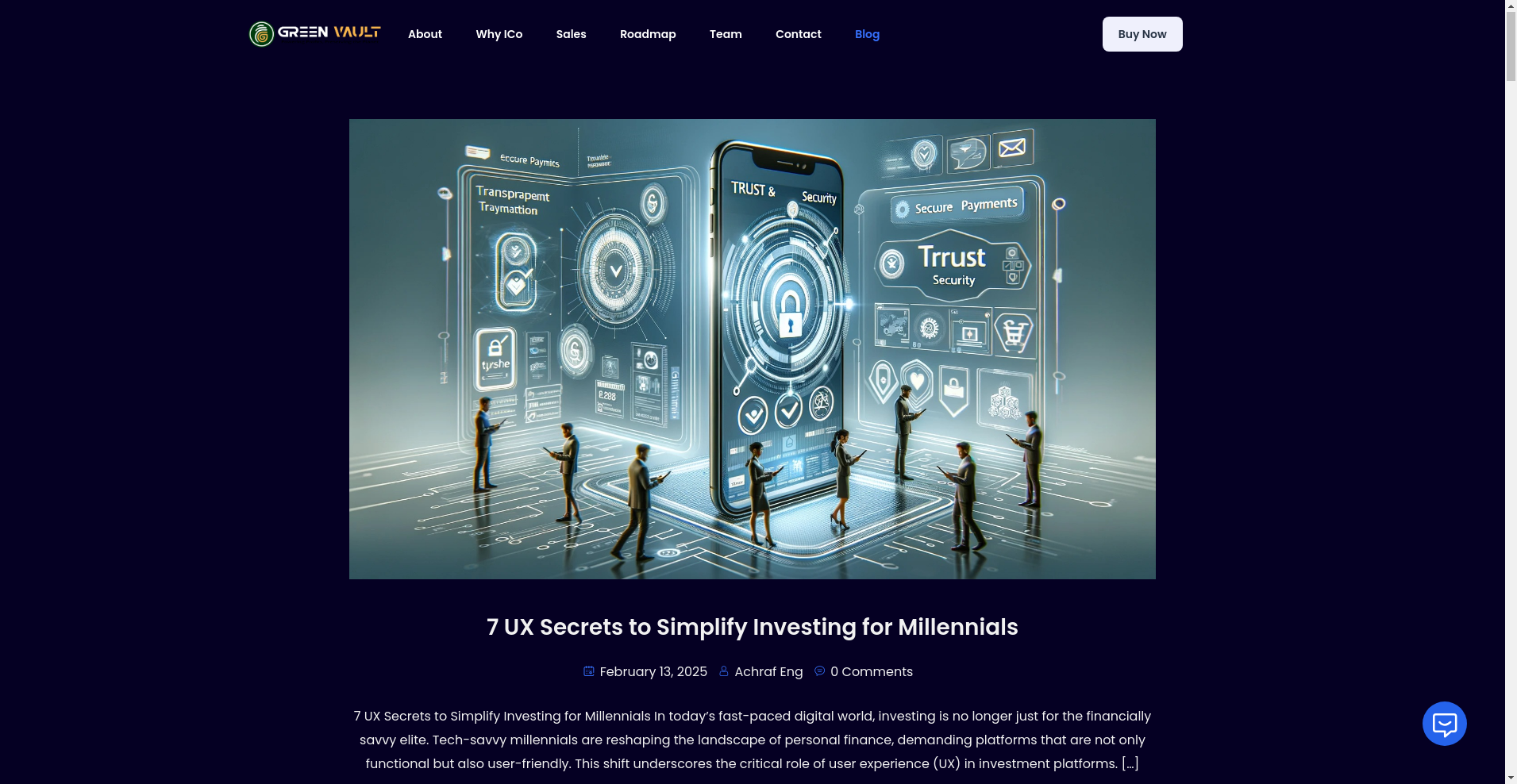GreenVault Review: Scam or Legit Crypto? Uncovering All The Red Flags

What Exactly Is GreenVault?
GreenVault claims to be a revolutionary environmental-focused blockchain project that marries sustainability with decentralized finance (DeFi). Its primary promise is to fund jojoba tree plantations in arid deserts, helping combat climate change and desertification while generating profits through jojoba oil sales and carbon credits. The project also promotes staking, NFT-backed tree ownership, and real-world environmental impact, positioning itself as more than just a meme token.
As an investigative piece, this article aims to scrutinize the legitimacy of GreenVault, its underlying promises, and the associated risks for potential investors. With numerous green projects promising sustainability and profits, it's crucial to separate fact from fiction before considering any involvement.

Who Is The Team Behind GreenVault?
One of the first red flags in evaluating GreenVault is the lack of transparent team information. According to publicly available data, the project does not disclose identifiable founders or core team members. The team remains anonymous, a common trait among dubious projects, raising questions about accountability and long-term commitment.
- **Anonymous Team:** No verified individuals or credible profiles associated with the project.
- **Roadmap Ambiguity:** The roadmap, while detailed in phases, lacks concrete milestones, timelines, or third-party audits to verify progress.
- **Strategic Credibility:** Claims of AI integration and environmental impacts are vague, with little evidence of real development or partnerships.
In conclusion, the absence of transparency about the team diminishes confidence in GreenVault's legitimacy, suggesting it may be a 'fake' project designed mainly for quick pump-and-dump schemes rather than sustainable growth.
GreenVault Security Audit: A Deep Dive into the Code
The sole available audit comes from Cyberscope, which assessed the GreenVault (GRVT) token on the Binance Smart Chain (BSC). While the project boasts a security audit—an essential step for establishing trust—there are notable concerns that warrant closer examination.
- Audit Status: The audit was completed in February 2025, and despite claiming to be a thorough review, it highlights critical vulnerabilities and high-criticality issues.
- Critical Vulnerabilities: The specific vulnerabilities are marked as 'high criticality', indicating potential security risks that could be exploited by hackers.
- Community and Decentralization Scores: The community score is only 35/100, and decentralization score similarly low at 35/100, signaling centralization and governance concerns.
- Transparency: The audit lacks detailed disclosure of the vulnerabilities found and the ongoing plans to remediate them, which raises red flags about transparency.
Overall, while the project has undergone an audit, the presence of high-critical vulnerabilities and low decentralization metrics suggest significant security and trust issues. Investors should exercise extreme caution, especially considering that an exploitation could result in loss of funds.
GreenVault Tokenomics: A Fair System or a Trap?
The tokenomics structure of GreenVault's GRVT token is central to understanding its potential for growth—or collapse. The total supply is fixed at 100 billion tokens, with a variety of allocations for presale, liquidity, rewards, team, and ecosystem development.
- Total Supply: 100,000,000,000 GRVT, a very high number, which could lead to inflationary pressures if not managed properly.
- Distribution & Allocation:
- Presale (PinkSale): 25%
- Liquidity Pool: 14.25%
- Team & Development: 10%
- Staking & Rewards: 15%
- Marketing & Partnerships: 10%
- NFT & Tree Rewards: 5.75%
- Reserve & Future Expansion: 20% (rough estimate)
- Utility: The token facilitates staking rewards, plantation funding, NFT ownership, and governance participation, tying its value to real-world environmental projects.
- Risks: High token supply and aggressive distribution raise suspicions of potential dump scenarios, especially if early investors decide to sell en masse once liquidity is unlocked.
The high token count, combined with a sizable percentage allocated for the team and pre-sale, often signifies potential for price manipulation or dump schemes. Investors should be wary of token inflation and the lack of clear vesting schedules, which could materially impact token value.
Is GreenVault a Ghost Town? Checking for Real Activity
From the available data—social media activity, project updates, and on-chain activity—GreenVault appears to be a relatively dormant project. Its Telegram community has around 276 members, and the official Twitter following counts at approximately 542 followers, which is modest for a project claiming environmental disruption at a global level.
The project’s website remains live, and a presale is active on PinkSale, but there are no confirmed partnerships, real-world pilot projects, or updates beyond initial promotion. The absence of active developer updates or community engagement suggests that GreenVault might be a 'paper project' designed solely for the pre-sale hype.
In addition, the lack of on-chain activity, trading volume, and verified operational milestones indicates that GreenVault might not be actualized beyond marketing material, reinforcing the suspicion that it's a potential scam or at best, a very high-risk speculative play.
What GreenVault's Legal Documents Are Hiding
- Limited Documentation: The project's white paper and terms of sale are available but lack detailed legal disclaimers, risk warnings, or investor protections.
- No Regulatory Compliance Disclosure: The project claims to be compliant but provides no verifiable regulatory approvals or audits beyond the token security review.
- Unclear Vested Token Schedules: No public vesting or lock-up periods are described, raising the risk of early dumps.
- Potential Pyramiding Risks: The multi-phase roadmap and reward models could incentivize new investors to pay off earlier backers, characteristic of pyramid or Ponzi schemes, especially with limited real backing.
Overall, the lack of transparency and legal safeguards in GreenVault's documentation points toward higher risks for investors, especially in a unregulated space where scams are prevalent.
Final Verdict: Should You Risk Investing in GreenVault?
Based on comprehensive analysis, GreenVault presents multiple suspicious indicators: an anonymous team, a security audit with critical vulnerabilities, inflated tokenomics prone to dumping, and minimal community engagement. While its environmental narrative is appealing, the underlying infrastructure and transparency are fundamentally questionable.
**Positives:**
- Some security audit has been conducted, indicating initial security considerations.
- Claims to support real-world environmental projects with tangible assets like NFTs and carbon credits.
- Limited information suggests efforts toward transparency, such as a publicly available white paper and roadmap.
**Major Red Flags:**
- Anonymous team with no verifiable credentials or track record.
- High-criticality vulnerabilities identified in the sole security audit.
- Modest social media presence and no evidence of real operational activity.
- Potential for token inflation and early dump risks due to high supply and unverified vesting schedules.
- Lack of regulatory disclosures or legal safeguards, increasing potential for scams or rug pulls.
Investors should exercise extreme caution and perform extensive due diligence before considering any involvement with GreenVault. Given the red flags and lack of verifiable progress, it remains highly risky and possibly fraudulent. Never invest beyond what you can afford to lose in unverified and opaque projects.

Sarah Wilson
Offensive Security Engineer
I'm a professional "white-hat" hacker. I think like an adversary to find holes in crypto projects before the bad guys do. My job is to break things so you don't get broken.
Similar Projects
-
Cryptex Finance
Cryptex Finance ($CTX) Review: An Expert Analysis of Risks & Potential
-
Biswap
Biswap Review: Scam Check & Legitimacy Analysis of a Failed Crypto Project
-
Zeebu
Comprehensive Review of Zeebu: Is This Telecom Blockchain Project a Scam or Legit?
-
UMA
UMA ($UMA) Review: A Deep Dive into Its Tech & Risks
-
eventflo
eventflo Review: Scam or Legit Crypto? Crypto Project Investigation